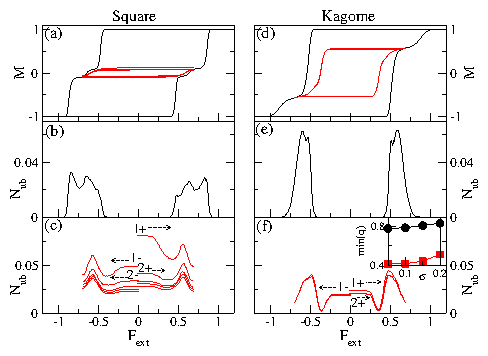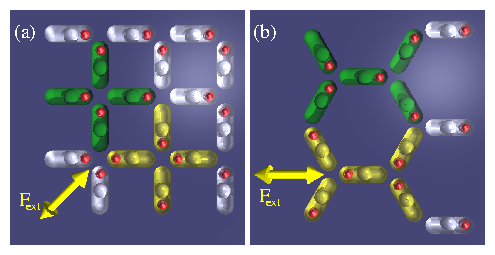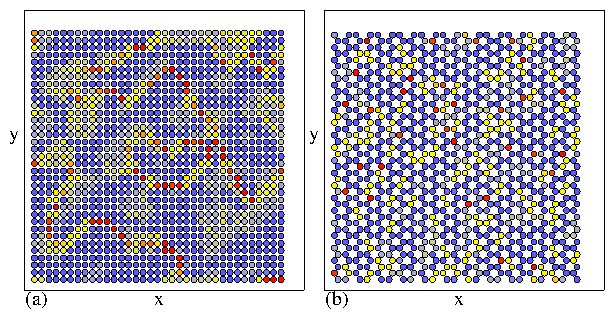 Figure 2: (Color online)
(a,b,c) Square ice sample with σ = 0.1. (d,e,f) Kagome ice
sample with σ = 0.1. All curves are averaged over ten disorder
realizations.
(a,d) The reduced magnetization m vs Fext.
Saturation occurs at m = ±1.0 when all the vertices are in
biased states.
Outer line: Saturated loop with
Fmax=2.0.
Inner lines: Consecutive loops with Fmax=0.7, below saturation.
The
initial curves are not shown.
(b,e) Fraction of unbiased vertices Nub
vs Fext for the saturated loop with Fmax=2.0.
(c,f) Nub vs Fext for repeated unsaturated loops
with Fmax=0.7, with cycle number n increasing from top to
bottom.
For clarity, we omit the horizontal lines connecting
Fext=±Fmax to Fext=0. The first few half cycles are
labeled; dotted arrows indicate sweep direction for the labeled curves.
There is a much greater decrease in Nub for the square ice than for
the kagome ice.
Inset of (f): min(q), the effective spin overlap in the n=2 cycle, vs
σ for (circles) kagome and (squares) square ice. Samples
with stronger disorder have higher q values.
Figure 2: (Color online)
(a,b,c) Square ice sample with σ = 0.1. (d,e,f) Kagome ice
sample with σ = 0.1. All curves are averaged over ten disorder
realizations.
(a,d) The reduced magnetization m vs Fext.
Saturation occurs at m = ±1.0 when all the vertices are in
biased states.
Outer line: Saturated loop with
Fmax=2.0.
Inner lines: Consecutive loops with Fmax=0.7, below saturation.
The
initial curves are not shown.
(b,e) Fraction of unbiased vertices Nub
vs Fext for the saturated loop with Fmax=2.0.
(c,f) Nub vs Fext for repeated unsaturated loops
with Fmax=0.7, with cycle number n increasing from top to
bottom.
For clarity, we omit the horizontal lines connecting
Fext=±Fmax to Fext=0. The first few half cycles are
labeled; dotted arrows indicate sweep direction for the labeled curves.
There is a much greater decrease in Nub for the square ice than for
the kagome ice.
Inset of (f): min(q), the effective spin overlap in the n=2 cycle, vs
σ for (circles) kagome and (squares) square ice. Samples
with stronger disorder have higher q values.
|

